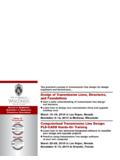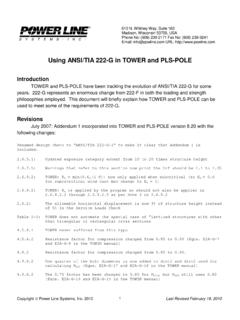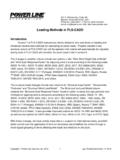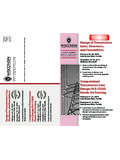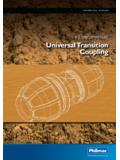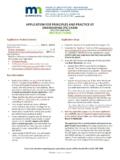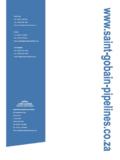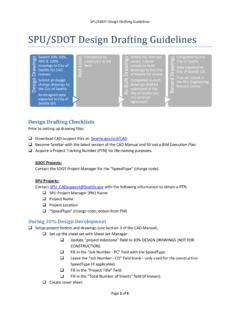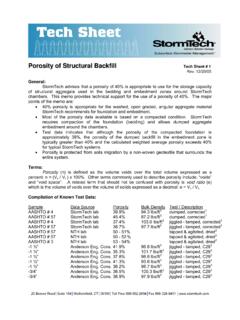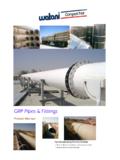Transcription of Electrical Transmission and Substation Structures ...
1 Wind Loading: Uncertainties and Honesty Suggest Simplification Alain H. Peyrot, PhD, PE1 1 Emeritus Professor of civil engineering , Univ. of Wisconsin, Madison, WI, USA Past President (1992 to 2008), Power Line Systems, Madison,WI, USA ABSTRACT This paper discusses some of the recent wind loading procedures for the design of Transmission lines (NESC, ASCE, IEC, CENELEC, etc.). It provides some detailed background behind their formulas for gust factors, span factors and gust response factors. It discusses the uncertainties inherent in each one of the parameters and assumptions behind the formulas: wind storm type, reference wind, terrain roughness, profiles, gustiness, time and spatial correlations, dynamic response, wind direction, drag coefficients, etc. It provides some examples to illustrate the current lack of consensus and to identify the important design parameters.
2 The paper concludes that the complexity of most current wind design procedures is not justified. Instead, it provides the rationale for simplifying the entire wind design process and it offers specific recommendations for achieving that goal. 1. INTRODUCTION The theoretical bases of the extreme wind provisions of some of the current generation of codes, standards or guides dealing with overhead Transmission lines (NESC, 2007; CENELEC, 2001; IEC, 2003; UK NNA, 2004; ASCE Manual 74, 2008; ASCE Manual 113, 2008; etc.) were developed in the 1960's and early 1970's by a very small number of individuals with very sophisticated mathematical skills (Davenport, 1961 and later; Harris, 1963; Manuzio et al, 1964; Castanheta, 1970; Cojan, 1973; Armitt et al, 1975). We will refer to all the above-mentioned documents as codes even when they do not have that status.
3 The mathematical bases of the wind models and associated structural responses borrowed from the random vibrations field (Crandall, 1963) and communication theory. For three decades, these provisions were published in draft documents and guides, but were not parts of legally binding documents. Therefore, they were mostly ignored. However, once the NESC in the US adopted Rule 250C in 2002, once the CENELEC document was finalized in 2001 and the IEC issued its Standard in 2003, it was no longer possible to ignore these provisions and they were finally tested by practicing engineers. This actual implementation revealed many problems and generated quite a few debates. In fact, the Europeans could never agree on a single approach and the CENELEC standard has an escape clause that allows each country to basically do what it wishes ( publish a National Normative Electrical Transmission and Substation Structures Conference 2009 ASCE184 Aspects, or NNA) as long as the general nomenclature is respected.
4 This is what most of them do. This writer is in a unique position to comment on the recent wind provisions as: 1) he has conducted academic research and taught graduate level and professional classes in wind engineering , reliability-based design and Transmission line design, 2) he has been a member of some of the CIGRE (CIGRE, 1990) and ASCE (ASCE Manual 74, 1984, 1991, 2008) committees that developed the recent wind provisions, 3) he has worked as a Transmission line consultant for many years and investigated line failures, and 4) he has participated in the implementation of the wind provisions of many international codes and standards in his company s design software (PLS-CADD & TOWER) that is used in over 100 countries. In doing so he has sometimes uncovered provisions that were simply untested, incomplete and confusing. Being confronted with so many ways of approaching the common problem of designing safe lines economically and practically, has led this writer to reflect on what we are doing, what is really justified and to suggest some simplifications.
5 This is the rationale for writing this paper and hopefully convincing future generations that: 1) there is nothing sacred behind the current code procedures, 2) the complexity of the problem is not amenable to its description by fancy equations, and 3) simpler formulations should be considered. Refining the wind loading equations has been part of the larger goal of improving design by what is now commonly known as Reliability Based Design (RBD). There was even some hope in the early days of RBD development, that given a sufficient amount of research and data collection, our industry would someday be able to quantify the probability of failure of a line (for example statistically determine the extent and number of failures of a line over a period of time).
6 However, in part because of the uncertainties described in this paper, other uncertainties related to the size of the storms and the corresponding number of exposed Structures , we will never be able to achieve this lofty goal. In spite of this shortcoming (inability to quantify the probability of failure), RBD is still a very valuable guide to develop consistent design procedures covering various combinations of loading events and materials (CIGRE, 1990 and 2006; ASCE Manual 111, 2006; Ghannoum, 2002; Mozer et al, 1984; Peyrot et al, 1984). Some concepts of RBD and simplicity are not incompatible. 2. TYPES OF WIND STORMS For the proper understanding of the various engineering approaches to the determination of wind loads on Transmission lines, it is imperative to have some knowledge of the various types of wind storms that may be damaging to our lines.
7 Recommended reading on this subject are CIGRE Brochures 256 (2004), 344 (2008) and 350 (2008). Here we will limit our discussion to winds with gusts in the range of 40 to 60 m/s (about 90 to 140 mph) that cover at least two spans. Tornadic winds, while extremely violent, generally cover less than two spans and their peak velocity values are generally not considered in the statistics that form the basis of the Basic/ Reference Wind maps produced around the world. While tornadic winds can be considered in design, for example as explained in ASCE Manual 74 (1991 and later), they will not be discussed in this paper. Electrical Transmission and Substation Structures Conference 2009 ASCE185 Extra Tropical Cyclones/ Winter Storms These storms are characterized by circulating winds around very low pressure zones: they are also referred to as cyclonic systems with very large diameters, say between 500 and 3000 km.
8 They commonly occur in North America and Europe in winter. They are the most studied storms with a well-defined boundary layer behavior and have been the basis of the Academic Winds discussed in Section While they are generally regarded as the storms that cause most Transmission line failures in Western Europe, this is not the case in most other regions of the world. For such winds, the motion of the air at heights above the boundary layer (at heights higher than the Gradient Heights generally considered to be higher than 250 m) is essentially parallel to the isobars and its velocity is referred to as the Gradient, Geostrophic or Synoptic Wind. Tropical Cyclones These are the well-known hurricanes/ typhoons/ cyclones that affect coastal areas during warm seasons.
9 Very high winds exist near the low pressure center of the storm (the eye). Tropical cyclones can be very damaging to lines due to their extent, duration and propensity to carry debris. Local Storms These include a large variety of storms from the classical convective cell thunderstorms to the squall line winds and downbursts (macroburst and microburst) that occur near advancing cold fronts. To distinguish them from those due to Extra-Tropical or Tropical Cyclone winds, such winds have also been referred to as High Intensity Winds or HIW. While local storms are smaller in size than winter storms, they are more frequent, and according to several authors (Dempsey et al,1996; de Oliveira, 2006), including the individual who produced the non-hurricane portion of the latest NESC and ASCE wind maps used in the US (Peterka, 1998 and 2005), and according to CIGRE Brochures 256 and 350 (CIGRE, 2004 and 2008), they are the cause of most wind failures in the USA, the central Canada, South America, South Africa and Australia.
10 Katabatic and Downslope Winds Katabatic winds develop on the leeward side of mountains or ridges when the air approaching on the windward side is colder and flows downhill into warmer valleys due to its higher density. Downslope winds can also be caused by dry warm air forced down mountain sides by strong winds aloft. The various Foen winds of Europe and the Chinook wind in the USA are well-known examples of downslope wind. Academic winds Given the wide variety of storm types and the fact that no two storms are alike (and Electrical Transmission and Substation Structures Conference 2009 ASCE186that their characteristics may even be affected by global climate change), it is understandable that it will never be possible, even statistically, to accurately predict future occurrences of winds, including their spatial and temporal variations.

